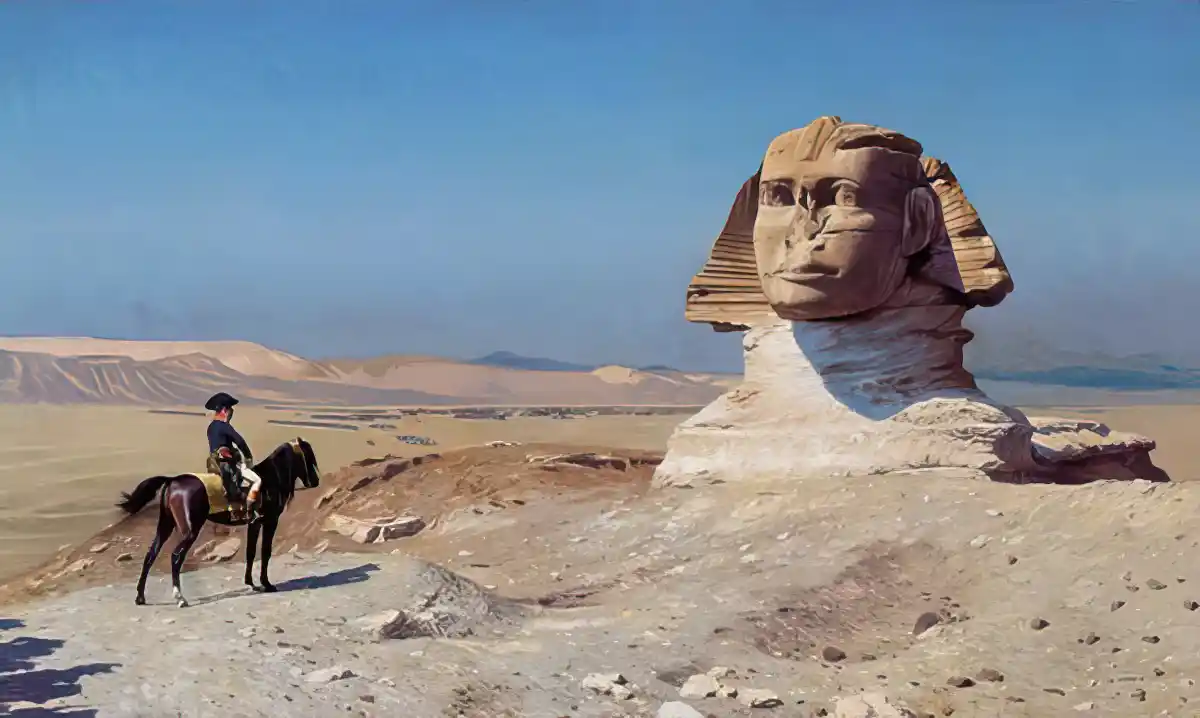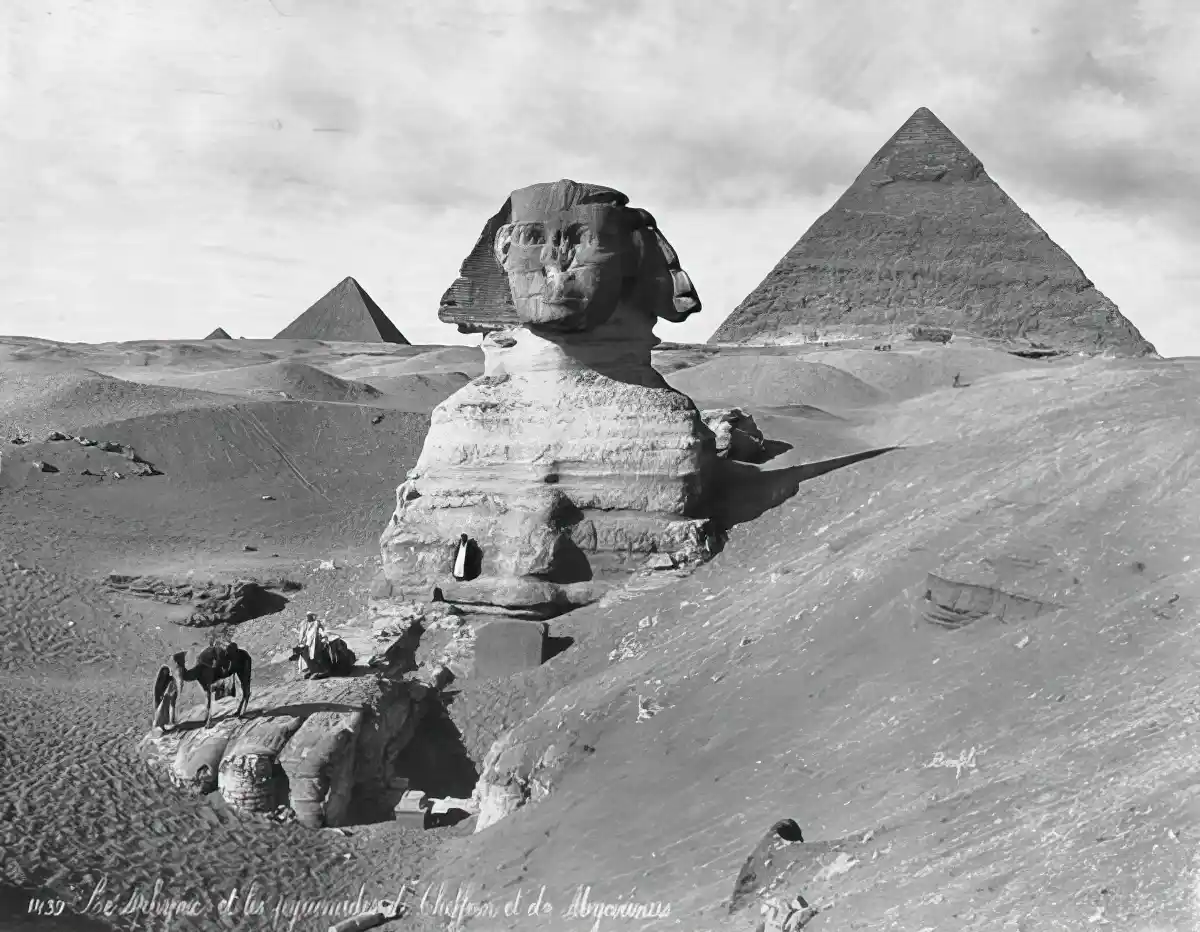Great Sphinx
The most extraordinary monumental sculpture in the ancient world, the Sphinx, is carved out of a single ridge of stone 240 feet (73 meters) long and 66 feet (20 meters) high. The head, which has a markedly different texture from the body and shows far less severe erosion, is a naturally occurring outcrop of harder stone. To form the lower body of the Sphinx, enormous blocks of stone were quarried from the base rock (and these blocks were then used in the core masonry of the temples directly in front and to the south of the Sphinx).
While a few stubborn Egyptologists still maintain that the Sphinx was constructed in the 4th Dynasty by the Pharaoh Chephren (Khafre), an accumulating body of evidence, both archaeological and geological, indicates the Sphinx is far older than the 4th Dynasty and was only restored by Chephren during his reign. No inscriptions on the Sphinx or on any of the temples connected to it offer evidence of construction by Chepren. Yet, the so-called 'Inventory Stele' (uncovered on the Giza plateau in the 19th century) tells that the Pharaoh Cheops - Chephren's predecessor - ordered a temple built alongside the Sphinx, meaning, of course, that the Sphinx was already there and thus could not have been constructed by Chephren.
Based on geological considerations, R.A. Schwaller de Lubicz has suggested a much greater age for the Sphinx. Schwaller de Lubicz observed, and recent geologists (such as Robert Schoch, Professor of Geology at Boston University) have confirmed that the extreme erosion on the body of the Sphinx could not be the result of wind and sand, as has been universally assumed, but instead was the result of water.
Geologists agree that Egypt experienced severe flooding in the distant past, and it is due to this flooding that we may attribute the surface erosion on the Sphinx. Wind erosion cannot occur when the body of the Sphinx is covered by sand, and the Sphinx has been in this condition for nearly all of the last five thousand years - since the alleged time of its 4th Dynasty construction. Furthermore, if wind-blown sand had indeed caused the deep erosion of the Sphinx, we would expect to find evidence of such erosion on other Egyptian monuments built of similar materials and exposed to the wind for a similar length of time. Yet the fact of the matter is that even on structures that have had more exposure to the wind-blown sand, there are minimal effects of erosion, the sand having done little more than scour clean the surface of the dressed stones.
Additional evidence for the great age of the Sphinx is shown by the astronomical significance of its shape, which is that of a lion. Roughly every two thousand years (2160 to be exact), and because of the precession of the equinoxes, the sun on the vernal equinox rises against the stellar background of a different constellation. For the past two thousand years, that constellation has been Pisces, the Fish, a symbol of the Christian age. Before the age of Pisces, it was the age of Aries the Ram, and before that, it was the age of Taurus the Bull.
It is interesting to note that during the first and second millennia BC, approximately the Age of Aries, ram-oriented iconography was familiar in Dynastic Egypt, while during the Age of Taurus, the Bull cult arose in Minoan Crete. Perhaps the builders of the Sphinx likewise used astrological symbolism in designing their monumental sculptures. The geological findings discussed above indicate that the Sphinx seems to have been sculpted sometime before 10,000 BC, and this period coincides with the Age of Leo the Lion, which lasted from 10,970 to 8810 BC.
Further support for this vast age of the Sphinx comes from a surprising sky-ground correlation proven by sophisticated computer programs such as Skyglobe 3.6. These computer programs can generate precise pictures of any portion of the night sky as seen from different places on Earth at any time in the distant past or future. Graham Hancock explains in his book Heaven's Mirror that "computer simulations show that in 10,500 BC the constellation of Leo housed the sun on the spring equinox - i.e., an hour before dawn in that epoch Leo would have reclined due east along the horizon in the place where the sun would soon rise. With its due-east orientation, this means that the lion-bodied Sphinx would have gazed directly on that morning at the one constellation in the sky that might reasonably be regarded as its celestial counterpart."
The preceding discussion means that the monumental sculpture of the Sphinx may have existed at a time when (according to prevailing archaeological theory) there were no civilizations on Earth, and humans had not yet evolved beyond hunter-gatherer lifestyles. This matter is so radical that scholarly reticence in acknowledging it is understandable. If the Sphinx is indeed this old, then contemporary assumptions regarding the development of civilization must be entirely reworked, and the enigmatic question of Plato's Atlantis should be seriously considered.
Readers interested in this matter, certainly as fascinating as the mystery of the Great Pyramid, are encouraged to consult the following books:
- The Traveler's Key to Ancient Egypt; by John Anthony West
- Serpent in the Sky; by John Anthony West
- Fingerprints of the Gods; by Graham Hancock
- Heaven's Mirror; by Graham Hancock
- The Message of the Sphinx; by Robert Bauval and Graham Hancock
- Voyages of the Pyramid Builders; by Robert Schoch
- Gods of Eden; by Andrew Collins

Martin Gray is a cultural anthropologist, writer and photographer specializing in the study of pilgrimage traditions and sacred sites around the world. During a 40 year period he has visited more than 2000 pilgrimage places in 160 countries. The World Pilgrimage Guide at sacredsites.com is the most comprehensive source of information on this subject.




